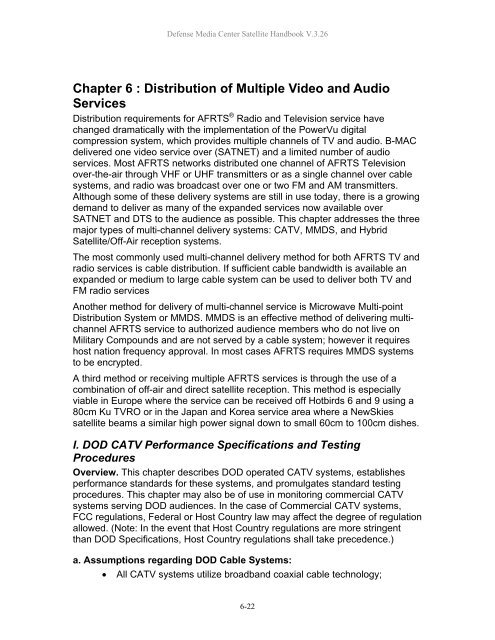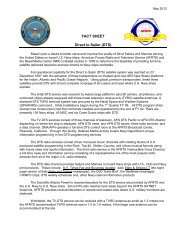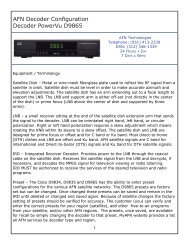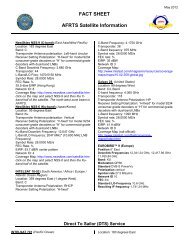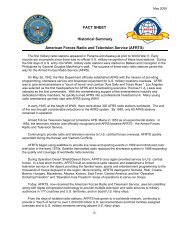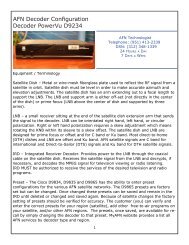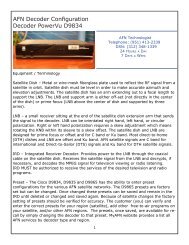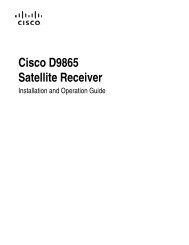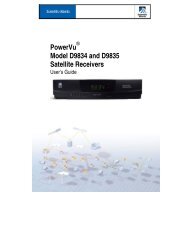AFRTS Defense Media Center Satellite Handbook
AFRTS Defense Media Center Satellite Handbook
AFRTS Defense Media Center Satellite Handbook
You also want an ePaper? Increase the reach of your titles
YUMPU automatically turns print PDFs into web optimized ePapers that Google loves.
<strong>Defense</strong> <strong>Media</strong> <strong>Center</strong> <strong>Satellite</strong> <strong>Handbook</strong> V.3.26<br />
Chapter 6 : Distribution of Multiple Video and Audio<br />
Services<br />
Distribution requirements for <strong>AFRTS</strong> ® Radio and Television service have<br />
changed dramatically with the implementation of the PowerVu digital<br />
compression system, which provides multiple channels of TV and audio. B-MAC<br />
delivered one video service over (SATNET) and a limited number of audio<br />
services. Most <strong>AFRTS</strong> networks distributed one channel of <strong>AFRTS</strong> Television<br />
over-the-air through VHF or UHF transmitters or as a single channel over cable<br />
systems, and radio was broadcast over one or two FM and AM transmitters.<br />
Although some of these delivery systems are still in use today, there is a growing<br />
demand to deliver as many of the expanded services now available over<br />
SATNET and DTS to the audience as possible. This chapter addresses the three<br />
major types of multi-channel delivery systems: CATV, MMDS, and Hybrid<br />
<strong>Satellite</strong>/Off-Air reception systems.<br />
The most commonly used multi-channel delivery method for both <strong>AFRTS</strong> TV and<br />
radio services is cable distribution. If sufficient cable bandwidth is available an<br />
expanded or medium to large cable system can be used to deliver both TV and<br />
FM radio services<br />
Another method for delivery of multi-channel service is Microwave Multi-point<br />
Distribution System or MMDS. MMDS is an effective method of delivering multichannel<br />
<strong>AFRTS</strong> service to authorized audience members who do not live on<br />
Military Compounds and are not served by a cable system; however it requires<br />
host nation frequency approval. In most cases <strong>AFRTS</strong> requires MMDS systems<br />
to be encrypted.<br />
A third method or receiving multiple <strong>AFRTS</strong> services is through the use of a<br />
combination of off-air and direct satellite reception. This method is especially<br />
viable in Europe where the service can be received off Hotbirds 6 and 9 using a<br />
80cm Ku TVRO or in the Japan and Korea service area where a NewSkies<br />
satellite beams a similar high power signal down to small 60cm to 100cm dishes.<br />
I. DOD CATV Performance Specifications and Testing<br />
Procedures<br />
Overview. This chapter describes DOD operated CATV systems, establishes<br />
performance standards for these systems, and promulgates standard testing<br />
procedures. This chapter may also be of use in monitoring commercial CATV<br />
systems serving DOD audiences. In the case of Commercial CATV systems,<br />
FCC regulations, Federal or Host Country law may affect the degree of regulation<br />
allowed. (Note: In the event that Host Country regulations are more stringent<br />
than DOD Specifications, Host Country regulations shall take precedence.)<br />
a. Assumptions regarding DOD Cable Systems:<br />
� All CATV systems utilize broadband coaxial cable technology;<br />
6-22


